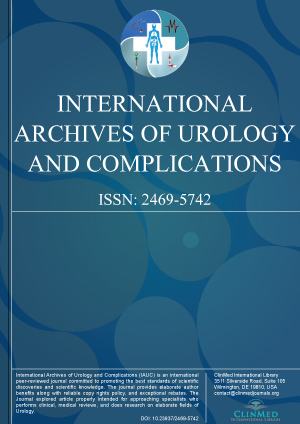Archive
Open Access DOI:10.23937/2469-5742/1510059
Dalia Saidan, Veenu Tyagi, Paraskeve (Voula) Granitsiotis and Karen Guerrero
Article Type: Original Research Article | First Published: June 01, 2019
Article Formats
- Abstract
- Full Article
- XML
- EPub Reader
Open Access DOI:10.23937/2469-5742/1510058
Huseyin Ozgur Kazan, MD and Bulent Erol, MD
Article Type: Research Article | First Published: May 13, 2019
Article Formats
- Abstract
- Full Article
- XML
- EPub Reader
Open Access DOI:10.23937/2469-5742/1510057
The Impact of the Rigid Catheter Guide on Trocar Injury during Mid-Urethral Sling Placement
Amin Tavakoli, BS, Azadeh Nasiri, MD and Felicia Lane, MD
Article Type: Research article | First Published: April 29, 2019
Article Formats
- Abstract
- Full Article
- XML
- EPub Reader
Open Access DOI:10.23937/2469-5742/1510056
Adama Ouattara, Abdoul Karim Pare, Aristide F Kabore, Boukary Kabre, Amidou Bako and Mickael Rouamba
Article Type: Research Article | First Published: April 26, 2019
Article Formats
- Abstract
- Full Article
- XML
- EPub Reader
Open Access DOI:10.23937/2469-5742/1510055
Small Cell Neuroendocrine Carcinoma of the Urinary Bladder: Rare Entity Associated to Poor Prognosis
M Chraibi1 and M Barqui
Article Type: Case Report | First Published: March 08, 2019
Article Formats
- Abstract
- Full Article
- XML
- EPub Reader
Open Access DOI:10.23937/2469-5742/1510054
New Parameters in Evaluation of PSA Decrease after Antibiotherapy; PSA half-life and PSA-ENT2.5
Oktay OZMAN and Zubeyr TALAT
Article Type: Research Article | First Published: March 01, 2019
Article Formats
- Abstract
- Full Article
- XML
- EPub Reader
Open Access DOI:10.23937/2469-5742/1510053
Alper Bitkin and Lokman Irkilata
Article Type: Research Article | First Published: February 06, 2019
Article Formats
- Abstract
- Full Article
- XML
- EPub Reader
Open Access DOI:10.23937/2469-5742/1510052
Endoscopic Vesicoureteral Reflux Treatment Outcomes in Patients with Voiding Dysfunction
Elif Altinay Kirli, Cagatay Dogan, Mehmet Hamza Gultekin, Zubeyr Talat and Bulent Onal
Article Type: Research Article | First Published: January 28, 2019
Article Formats
- Abstract
- Full Article
- XML
- EPub Reader

Volume 5
Issue 1
Issue 1
